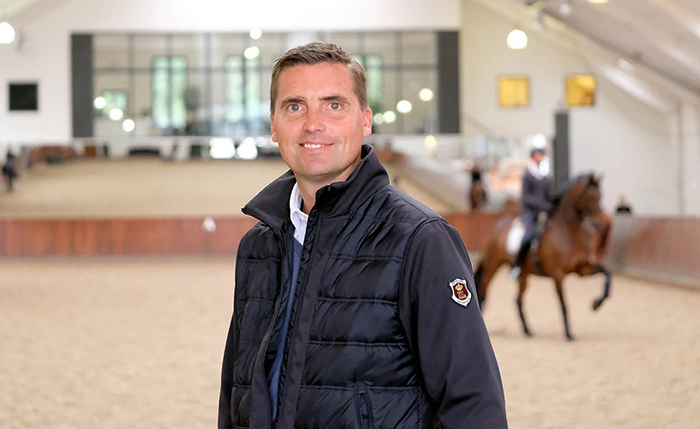
Christopher Hector interviews one of the key players in world dressage breeding… Andreas Helgstrand
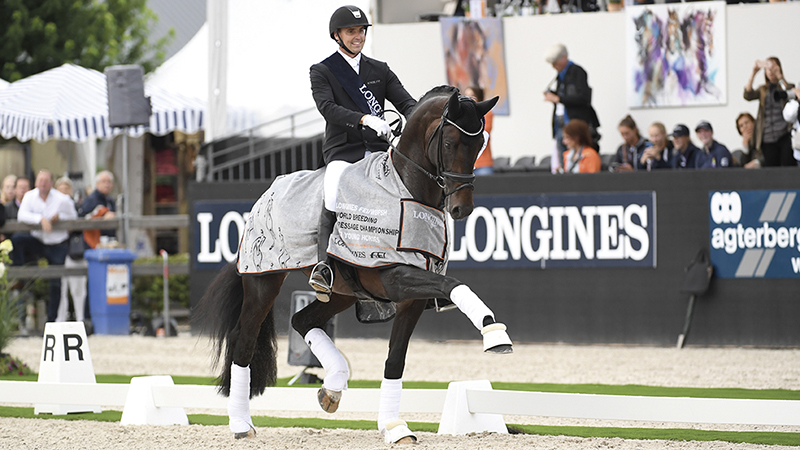
Andreas and one of his stallion stars – a young horse champion, now Grand Prix – Jovian
Andreas Helgstrand is one of the most influential people in the world of dressage horse breeding, his stallion station – in partnership with Paul Schockemöhle – dominates the dressage breeding market, it was good to catch up with him at the Amsterdam show…
You have an extraordinary record of finding stallions, if I ask about all of them we could go for hours, but what are the most important stallions you have discovered?
“That’s really hard to say, we have fifty, they all have some good things and some bad things. For a breeding stallion they have to be a natural mover, not that you need to make them move. A good stallion is born with good walk, trot, canter and rideability, this is one of the most important things. I’m looking at three gaits, that’s very important. Long lines, that they are not too tight in the body, they have something to give further. Then later on when you start riding them, the rideability is everything. Without that, forget it. We see so many good movers and they are still not easy to ride, they need to have a good mouth, good rideability. The best horses nowadays have no weakness, so we need to go in that direction. They need to be healthy, standing straight on the legs.”
“I know everyone says the same, but if you have in mind always that the best ones today have no weakness, they are doing piaffe, passage, they stand still, they are walking, they are doing all these exercises and that’s what you need to look for. ”
Is rideability the reason for the Vivaldi boom at the moment…
“I don’t know if there is a Vivaldi boom at the moment?”
I think so, in Germany…
“Which ones?”
Vitalis in particular…
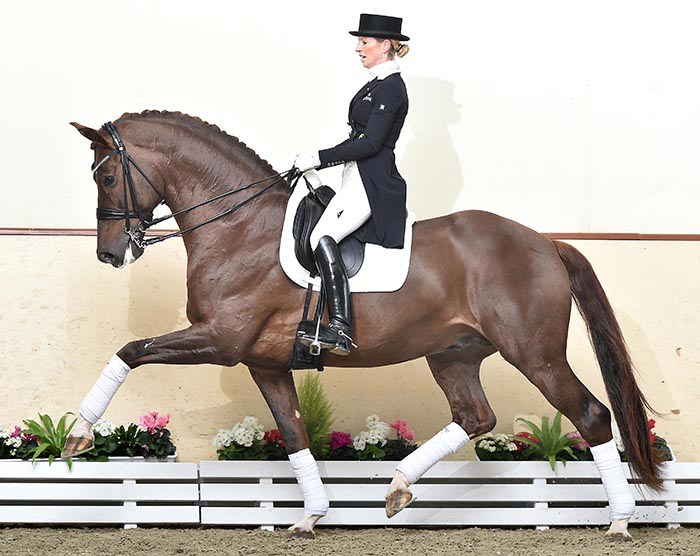
Vitalis
“True but let’s say now, Vitalis is still interesting but he’s already an older stallion and there are now hundreds of offspring from him, so now you have the option to use some of the newer ones. Of course, Vitalis made a fantastic, super breeding stallion, but it is important not to stay there, move all the time. What we always try to do is buy the best ones in the new age groups. We try to get new bloodlines in all the time from the younger stallions because then you are moving the breeding.”
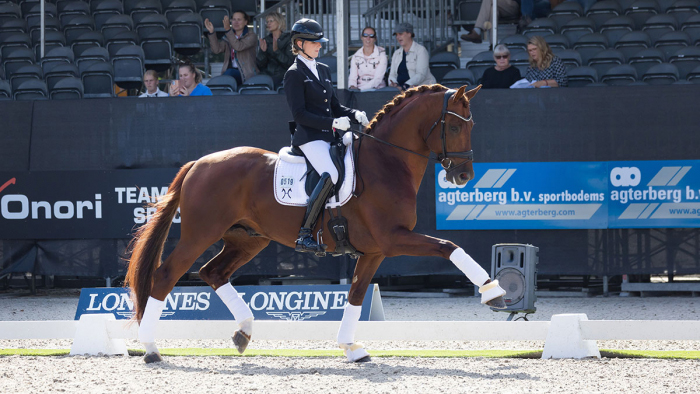
The next generation, Vitalos, by Vitalis out of a De Niro mare, he was reserve champion in the Five Year Old class at the 2022 World Young Horse championship
“I have many questions, I would like to use the old famous stallions, Jazz, Don Schufro, Sandro Hit, but then you are not moving anything, then you are already twenty years behind. That’s the same when you do a lot of ICSI embryo blah, blah, blah, it’s good, I do it myself on the better mares, but we always have to remember that the breeding goes so fast that if you have been out of it, three to five years, you cannot realise how good they are now. ”
When you are looking for rideability, are you looking for any particular names on a pedigree?
“It’s more that I am aware if the father is difficult in the character – and there’s a few stallions now in the market and I know their fathers were super difficult to ride – then I’m a little bit worried. Of course that’s not all of them, some will turn out very good, but when I know the father was very difficult to ride, then I am always a bit sceptical.”
On the positive side do you like to see, say Rubinstein, on the pedigree?
“R blood is often easy to ride and they are very nice horses, but they are also often a bit heavy and a bit strong in the mouth, so I think you cannot use these older names any more, what you need to look for are the horses that are eight to ten years old now, the ones that are twenty or more, forget it because they are not useful any more. If you look back, you mentioned Vivaldi, if you look at him now, and take him up in front of some of the younger ones, you will say, look how far the breeding has come, but at that time, wow, he was super!”
“It is fantastic for the breeding that the development comes so fast.”
Is there going to be a point where we say the development has gone to the limit?
“No. It will never come to the limit, but what is really hard to find is the horse with no weakness and that is why they get so expensive. For example this year we bought the Viva Gold son, the Westfalen champion, but this horse had walk, trot, canter, type, rideability, sensitivity, but there are also another hundred who could see that., that’s why they get so expensive at the auctions, and he was by far the best stallion that was at the stallion market.”
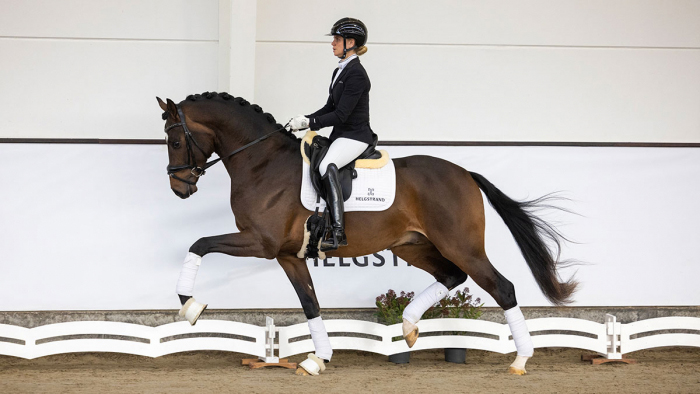
V-Power by Viva Gold x Fidertanz, 2022 Westphalen Champion Stallion and his rider, Mette Sejbjerg Jensen.
When do you like to see them, as two, three year olds?
“I buy most of them when they are two and a half, some three, but this year we will buy all these foals from our own stallions, we will have around 30 approved stallions when we have done from our own group. I think that’s a very high number out of not even 100 foals, that’s pretty good. We are very selective ourselves, and we could get way more approved, but that’s not good enough as a breeding stallion. We will find out later with that 30 which are good enough and which not, because we can have a champion, or a premium stallion, that looks super by hand, lunging, but when you start riding him, it’s not as good as the one that was just approved.”
“We’ve seen that many many times that they are surprising when you put the saddle on.”
Do you want to ride those young stallions before you buy?
“No it’s difficult, it’s too late by then, you need to take the risk otherwise there will be 20 people before you. What we do, I have Esben Møller and a few other guys, driving around every day to see horses, to visit the stables and the breeders – that makes it, not easy, but easier. We are ahead of a lot of other people.”
Are you trying to anticipate what the fashion is going to be next season, are the breeders going to be looking for a particular type, a colour even…
“Yeah, there are trends, before if a stallion was black then he will breed but I think people are over that point now, but they follow trends, for example, people don’t want a horse with flat front legs any more, they don’t want it. When I am standing in my own indoor trying to sell my normal riding horses and they come in and they have a flat canter, and the walk is pacing, forget it, it’s over these times. And they still approve tons of stallions that move like that, stallions with no shoulder freedom, no walk, but forget it, these are horses no-one wants to buy.”
There’s now a very rapid turnover of stallions, I believe that 21 stallions that were in your last catalogue are missing from this one…
“We kick them out ourselves, I think it is my responsibility to kick them out if they are not good enough, or sometimes they have been sold. In general if they are not breeding enough, out they go. Even if I think it’s a superstar, if the breeders don’t use him, it costs tons of money to run a breeding station, that’s why you see there are less and less stations now because there’s no money in it. People think, oh they make so much money out of the breeding station, but you don’t, there’s so much work, with vets, with all kinds of things, and still the breeding fee is one thousand euros, it’s been the same amount for years, and you buy horses for millions. That makes no sense, the normal stallion costs a thousand, the superstar costs a thousand, it’s crazy.”
“But I don’t want that the breeders stop breeding because for me the most important thing is not the breeding fee, it’s later on when I come and buy the foals. It’s important that I motivate these breeders to continue because that’s my biggest fear, that they stop breeding.”
Is it a problem for the breeder if he sends his mare to a stallion, then next year he is no longer a stallion…
“If the foal is good, it’s good, but there’s no guarantee, I can’t look into the stars to see if that stallion turns out like we hoped. We put them in because we believe it’s a good one, but some just turn out not like we thought they would, then it is better to stop quick, not good enough, we put some better ones in. New bloodlines. Sometimes they blame us, yes, but actually we don’t do it for no purpose, we do it because we need to do it.”
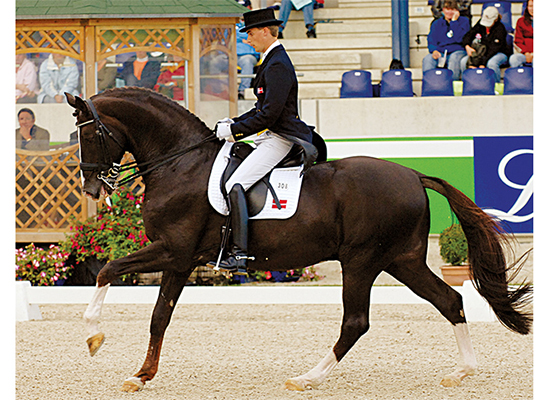
Andreas and Don Schufro
You rode one of the great stallions, that will be remembered and talked about as long as people are breeding sporthorses, are we going to see again stallions that dominate like Donnerhall, Sandro Hit, and Don Schufro again, or are there just so many stallions that no new dominant stallion is going to emerge?
“No. I am sure you will see that again. You mentioned before Vitalis, he was one of them, but he is also in a station where they have tons of mares, and that makes it easier to get 300 mares. We have a stallion, Dynamic Dream and he covers 500, 600 mares every year and the offspring they look fantastic. But let’s see now, they are coming two , but it looks very promising for that stallion and he’s the most used stallion we have in the last three years so let’s see how they are turning out, but it’s still no guarantee.”
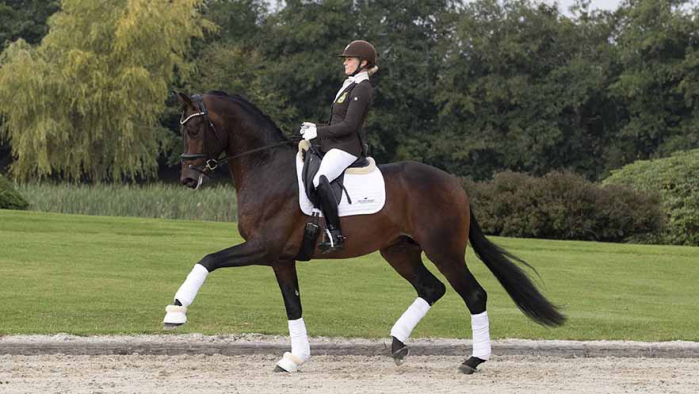
Dynamic Dream
“I think it’s important the stallion gets big numbers because then people don’t talk about all the bad ones they talk about the ten superstars they made. That will also help a stallion because you learn which mares they fit for.”
If Facebook had been going when you were riding Don Schufro, and they discovered he was WFFS positive, holy hell, dressage breeding would have been much poorer…
“I agree but then when we started with the WFFS we went, oh that’s dangerous, now people are relaxed about it. Okay Paul and I said, we give a guarantee, €10,000 if anyone has a dead foal from one of our stallions.”
And has anyone claimed the €10,000?
“No, exactly. Okay we have to be genetically careful and everything goes right, but at the same time we have to take a little bit of risk. You have Studbooks that are afraid of doing something extreme, and they prefer to go to a 7 or an 8, instead of sometimes go for the trot that is a ten but maybe has a shitty canter. But sometimes you need the extreme to develop your own breeding and if you know your mare, okay this mare has a super canter and I need more trot, okay you go for the one who has the best trot you can find, but if you only go for average, then you are not moving anywhere.”
Do you think those breeding associations are in the process of disappearing and we will end up with one German riding horse, one Danish riding horse?
“It may be too early to say that, but I agree it’s all the same blood, and if they can’t finance the studbooks … I mean the studbooks live off auctions, but we can often buy these horses before the auctions because the owner needs to pay like a 30% fee out of a sale, and of course, they can make this money themselves. It is hard for the studbooks because the better horses, the breeders can market themselves with facebook, or linked in or whatever. That will make it harder for the studbooks and they have to think, how can we survive this, because they are doing a good job most of them, but I do think it is important to re-think everything.”
The most used stallion in Holland in the most recent season was Dutch / Danish, why has this cross worked so well?
“I don’t know if it worked well, I think it is because they are screaming for new bloodlines in Holland. In Holland they have been too much using own blood and now they look outside. We have a big market in Holland with our stallions with German or Danish blood. With stallions how many mares depends on which stallion station they are in, the stallion you mentioned is in a popular station, and where they have a lot of mares so he gets many opportunities. You cannot be sure that the numbers are because the horse is good or not.”
Are your stallions breeding more or fewer mares this season?
“I think it is quite the same. Denmark up, Germany the same, Holland more. In America only frozen semen but we sell a lot to America and Australia.”
ends
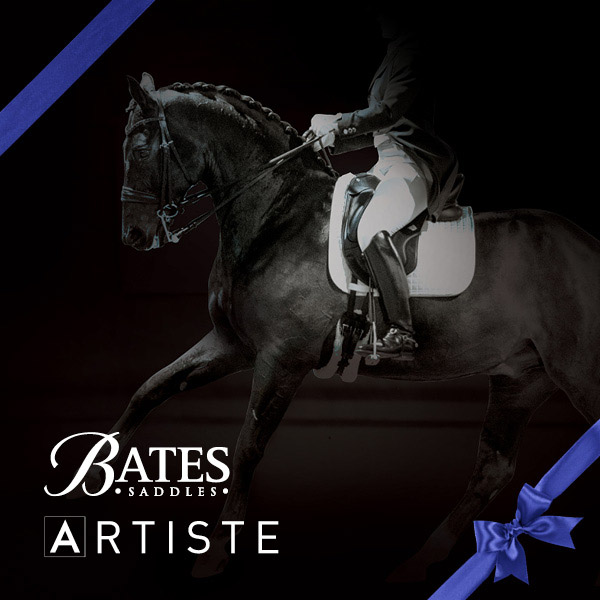

I believe this interview displays what Andreas is all about. Sure doesn’t seem to have any love for the horses just the money that can be obtained by them. If a nice stallion doesn’t breed enough it’s on to the next new flavor of the month. So sad that we will see the demise of nice German lines like the R and W for the sake that the new studs are better.
I agree with the above comment ,in that it all seemed to be a dash for the latest name, walking over tried and true breeding lines that can produce the top marks, and still be rideable. Fancy having 500/600 hundred mares, all covered by the same stallion. Perhaps the TB breeders have it correct.